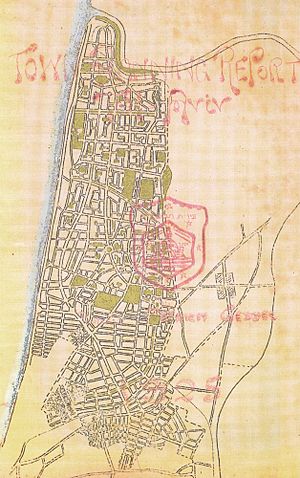Geddes Plan for Tel Aviv facts for kids
The Geddes Plan for Tel Aviv was the very first big plan for how the city of Tel Aviv would be built. It was created between 1925 and 1929 by a Scottish city planner named Sir Patrick Geddes. This plan shaped the center of Tel Aviv and the area now called "Old North".
In 1925, Patrick Geddes was asked to design a master plan for Tel Aviv. His plan was officially accepted in 1929. Tel Aviv became a special example because it was one of the few places where Geddes's ideas were built almost exactly as he imagined. It's a great example of an early planned city. The part of Tel Aviv that Geddes planned is about 7.5% of the city today. It was meant to be an extension of the older port town of Jaffa, which is to the south. It also aimed to be a home for the growing number of Jewish people moving to the area, mostly from Eastern Europe.
Contents
What Made the Geddes Plan Special?
Geddes was originally a biologist and sociologist. He used ideas from these fields to design Tel Aviv. His plan had principles that are very similar to what we now call "New Urbanism." This means he focused on making the city friendly for people walking, not just cars.
Focusing on People, Not Just Cars
Geddes wanted to create a strong sense of community. He did this by including many town squares and lots of green spaces. This focus on nature also helped reduce the city's impact on the environment. Private car traffic was kept to a minimum. The city was designed so people could easily walk everywhere. This focus on local neighborhoods has been key to Tel Aviv's success.
The "Super Block" Idea
Another important part of Geddes's plan was using "super blocks." These were popular in the early 1900s. A super block is a very large city block surrounded by major roads. Inside these large blocks, there were narrow, one-way streets. These streets were designed to stop cars from driving through quickly. The goal was to help people feel more connected within their own block. Geddes planned for each super block to have a public space in the middle, like a garden or a public building. However, because of business needs, not many of these central spaces became public gardens.
Green Spaces and Gardens
Geddes was inspired by the "Garden City" movement. This idea, developed by Ebenezer Howard, focused on bringing nature into cities. Geddes wanted to make sure that green areas were a big part of Tel Aviv. So, his plan limited how much of a building plot could be covered by buildings. Buildings could only take up one-third of a site. This rule helped make sure neighborhoods had plenty of lush greenery.
Architectural Style
Geddes did not say exactly what style the buildings should be. Usually, a Garden City would try to use a traditional style for the area. But Geddes knew that most people moving to Tel Aviv were immigrants from Europe. He encouraged them to create a unique "Jewish style" of architecture. Interestingly, Geddes did not give many details about this style in his plan.
Changes Over Time
After Geddes's plan was built, some parts of the city started to look old and worn out. People were not happy with this decay. This led to a lot of new building in the 1950s. However, people soon felt sad when old buildings were torn down for new ones. Because of this, a lot of effort was made to save the historic neighborhoods Geddes had planned. In 1984, a special group was created to protect these buildings and sites.
What People Said About the Plan
Some people have said that Tel Aviv is not a beautiful city in the traditional sense. They often blame the quality of the early buildings. They said the apartment buildings looked like "stacks of packing cases with shoeboxes for balconies."
Another criticism is that the city has struggled with its growing population. There are also many more private cars than Geddes imagined. Poor building quality and a lack of proper care have also been mentioned as problems.
Even with these criticisms, Tel Aviv is seen as a very successful city. It is a symbol of modern-day Israel. While it faces challenges like traffic, just like other cities, Geddes's plan laid a strong foundation.
Images for kids



